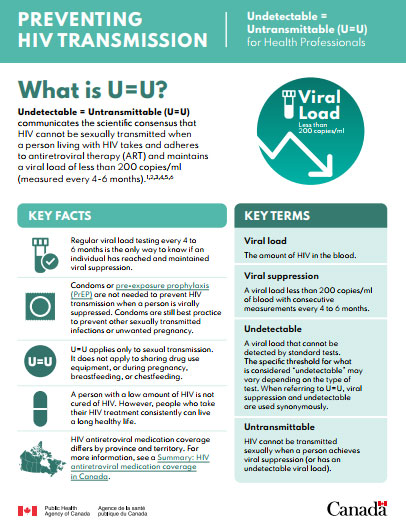Preventing HIV transmission: Undetectable = Untransmittable (U=U) for health professionals (fact sheet)
Download the PDF format
(PDF format, 196 KB, 2 pages)
Organization: Public Health Agency of Canada
Date published: 2023-12-05
ISBN: 978-0-660-68946-3
What is U=U?
- Undetectable = Untransmittable (U=U) communicates the scientific consensus that HIV cannot be sexually transmitted when a person living with HIV takes and adheres to antiretroviral therapy (ART) and maintains a viral load of less than 200 copies/ml (measured every 4-6 months)Footnote 1Footnote 2Footnote 3Footnote 4Footnote 5Footnote 6.
Key facts:
- Regular viral load testing every 4 to 6 months is the only way to know if an individual has reached and maintained viral suppression.
- Condoms or pre-exposure prophylaxis (PrEP) are not needed to prevent HIV transmission when a person is virally supressed. Condoms are still best practice to prevent other sexually transmitted infections or unwanted pregnancy.
- U=U applies only to sexual transmission. It does not apply to sharing drug use equipment, or during pregnancy, breastfeeding or chestfeeding.
- A person with a low amount of HIV is not cured of HIV. However, people who take their HIV treatment consistently can live a long healthy life.
- HIV antiretroviral medication coverage differs by province and territory. For more information, see a Summary: HIV antiretroviral medication coverage in Canada.
Key terms:
- Viral load: The amount of HIV in the blood.
- Viral suppression: A viral load less than 200 copies/ml of blood with consecutive measurements every 4 to 6 months.
- Undetectable: A viral load that cannot be detected by standard tests. The specific threshold for what is considered "undetectable" may vary depending on the type of test. When referring to U=U, viral suppression and undetectable are used synonymously.
- Untransmittable: HIV cannot be transmitted sexually when a person achieves viral suppression (or has an undetectable viral load).
Make U=U part of your practice
Integrating U=U into routine HIV care has several benefits:
- Improved health and wellbeing: When patients know about U=U, they are more likely to initiate and adhere to treatment, which leads to better health outcomes.
- Preventing transmission: Effective treatment prevents HIV from being passed on and reduces new infections.
- Improved patient relationships and reduced stigma: Discussing U=U as part of regular sexual health messaging can help change the way people think and talk about HIV by enabling conversations about sex without fear or shame.
- Empowerment: U=U empowers people living with HIV to have control of their well-being and make informed choices about their sexual health.
For more information, visit Canada.ca/HIV.
Footnote
- Footnote 1
-
Cohen MS, Chen YQ, McCauley M, Gamble T, Hosseinipour MC, Kumarasamy N, et al. Prevention of HIV-1 infection with early antiretroviral therapy. N Engl J Med. 2011;365(6):493-505.
- Footnote 2
-
Cohen MS, Chen YQ, McCauley M, Gamble T, Hosseinipour MC, Kumarasamy N, et al. Antiretroviral therapy for the prevention of HIV-1 transmission. N Engl J Med. 2016;375(9):830-839.
- Footnote 3
-
Rodger AJ, Cambiano V, Bruun T, Vernazza P, Collins S, van Lunzen J, et al. Sexual activity without condoms and risk of HIV transmission in serodifferent couples when the HIV-positive partner is using suppressive antiretroviral therapy. JAMA. 2016;316(2):171-181.
- Footnote 4
-
Rodger AJ, Cambiano V, Bruun T, Vernazza P, Collins S, Degen O, et al. Risk of HIV transmission through condomless sex in serodifferent gay couples with the HIV-positive partner taking suppressive antiretroviral therapy (PARTNER): final results of a multicentre, prospective, observational study. Lancet. 2019;393(10189):2428-2438.
- Footnote 5
-
Bavinton BR, Pinto AN, Phanuphak N, Grinsztejn B, Prestage GP, Zablotska-Manos IB, et al. Viral suppression and HIV transmission in serodiscordant male couples: an international, prospective, observational, cohort study. Lancet HIV. 2018;5(8):e438-e447.
- Footnote 6
-
LeMessurier, J., Traversy, G., Varsaneux, O., Weekes, M., Avey, M. T., Niragira, O.,... & Rodin, R. (2018). Risk of sexual transmission of human immunodeficiency virus with antiretroviral therapy, suppressed viral load and condom use: a systematic review. Cmaj, 190(46), E1350-E1360.
Page details
- Date modified:
